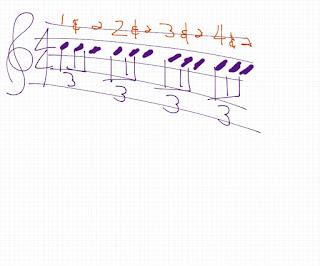They have two names:
compound major 2nd major 9th
compound major 3rd major 10th
compound perfect 4th perfect 11th
compound perfect 5th perfect 12th
compound major 6th major 13th
compound major 7th major 14th
compound perfect octave perfect 15th
If we look at the picture below, the highest note on the bottom stave with the bass clef is A. Then look at the second note on the top stave with the treble clef, it is E. The distance between these notes are larger than an octave, A, B, C#, D, E, F#, G#, A, B, C#, D, E. This interval is a compound perfect 5th or perfect 12th. When calculating the interval from the second A, A to E is five notes, so it is a perfect interval.
If we look at the fifth note on the top stave with the treble clef. It is an F#, so the interval between the A on the bottom stave and the F# on the top stave is a compound major 6th or a major 13th, A, B, C#, D, E, F#, G#, A, B, C#, D, E, F#.
If we look at the seventh note on the top stave with the treble clef. It is a G#. The interval between the A on the bottom stave and the G# on the top stave is a compound major 7th or a major 14th, A, B, C#, D, E, F#, G#, A, B, C#, D, E, F#, G#.
As with all intervals, the interval is worked out from the lowest note. If it is A, we use the scale of A major, if it is D, we use the scale of D major. All the intervals we have worked out from the picture have an A as the lowest note, so we think in the scale of A major. It has A, B, C#, D, E F#, G#, A.
-

- Photo credit: Internet Archive Book Images via Foter.com / No known copyright restrictions
Taylor, E. (1990). Music Theory In Practice Grade 5. London: The Associated Board of the Royal Schools of Music, pp. 27 and 28.

 Image By Louise MacPherson 24/12/2016
Image By Louise MacPherson 24/12/2016










































